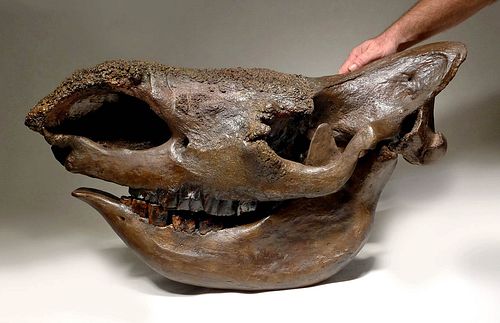Belgian Pleistocene Fossilized Woolly Rhinoceros Skull
Lot 163a
About Seller
Artemis Fine Arts
686 S Taylor Ave, Ste 106
Louisville, CO 80027
United States
Selling antiquities, ancient and ethnographic art online since 1993, Artemis Gallery specializes in Classical Antiquities (Egyptian, Greek, Roman, Near Eastern), Asian, Pre-Columbian, African / Tribal / Oceanographic art. Our extensive inventory includes pottery, stone, metal, wood, glass and textil...Read more
Categories
Estimate:
$60,000 - $90,000
Absentee vs Live bid
Two ways to bid:
- Leave a max absentee bid and the platform will bid on your behalf up to your maximum bid during the live auction.
- Bid live during the auction and your bids will be submitted real-time to the auctioneer.
Bid Increments
| Price | Bid Increment |
|---|---|
| $0 | $25 |
| $300 | $50 |
| $1,000 | $100 |
| $2,000 | $250 |
| $5,000 | $500 |
| $10,000 | $1,000 |
| $20,000 | $2,500 |
| $50,000 | $5,000 |
| $100,000 | $10,000 |
| $200,000 | $20,000 |
About Auction
By Artemis Fine Arts
Mar 9, 2023
Set Reminder
2023-03-09 10:00:00
2023-03-09 10:00:00
America/New_York
Bidsquare
Bidsquare : Exceptional Ancient, Ethnographic, & Fine Art
https://www.bidsquare.com/auctions/artemis-gallery/exceptional-ancient-ethnographic-fine-art-12354
Artemis Fine Arts info@artemisgallery.com
Artemis Fine Arts info@artemisgallery.com
- Lot Description
*This item may be oversized. Please inquire about shipping prior to bidding.
Western Europe, Belgium, Meuse River, Pleistocene (Ice Age), ca. 120,000 to 20,000 years ago. This is a very rare and scarce fossilized woolly rhinoceros skull and this is the first opportunity we have been able to offer a complete rhino skull from Belgium! Now extinct, the head of the ancient beast presents a chocolate brown hue, lengthy, rounded snout, a pair of sizable nostrils, sunken eyes, and teeth, each showing a thick enamel and the swirling structure of the internal cavity. While a fossil woolly rhino skull from any location is rare when found with this level of preservation, finding one from Europe makes this an especially note-worthy piece, since modern dredging machinery now destroys these fossils! This skull was discovered during a river dredge in the 1960s before the unfortunate change in the machinery used today. This is a rare opportunity to acquire this European skull, since they only come from older collections! Size: 32" L x 14.5" W (81.3 cm x 36.8 cm)
It has been decades since fossils like this have been discovered in the once productive gravel mine dredges that operated on the rivers of western Europe. Today, the machinery brings up the gravel (and fossils) by suction dredge and all the material is ground up and destroyed before being deposited in the barges. In the past, the dredges operated by bucket, so it was possible to find some amazing specimens; but this has not been the case for well over two decades in western Europe. The permanent change in river dredge technology has made these rare fossils even more rare as present-day discoveries like this are impossible. These European finds can therefore only come from older collections, and opportunities to acquire these pieces are seldom - this rhino skull is an exceptional chance to own one!
Regardless of their massive bodies and brutish appearance, woolly rhinoceros primarily fed upon grasses and sedges in the mammoth steppe, hence their downward facing heads, flat teeth, and lack of incisors. This fact is lucky for the paleolithic humans who not only lived beside them, but also drew representations of the ancient rhinos on cave walls in France and built statuettes of beasts in the Czech Republic. Interestingly, however, when a fossilized head of the animal was first recovered in 1335 in Austria, it was believed to belong to a dragon, and later in 1590, it became classified as an "ancient griffin." By the 18th and 19th century, researchers began to recognize the animal as part of the rhinoceros family, yet having the fur of a woolly mammoth, part of the elephant family.
Provenance: ex-private Dutch collection; ex-private Belgian collection
All items legal to buy/sell under U.S. Statute covering cultural patrimony Code 2600, CHAPTER 14, and are guaranteed to be as described or your money back.
A Certificate of Authenticity will accompany all winning bids.
We ship worldwide and handle all shipping in-house for your convenience.
#167882Professionally repaired and restored with only 10% new material on jaw and skull. All teeth are original. Interesting surface texture on dorsal horn area.Condition
- Shipping Info
-
All shipping is handled in-house for your convenience. Your invoice from Artemis Gallery will include shipping calculation instructions. If in doubt, please inquire BEFORE bidding for estimated shipping costs for individual items.
-
- Buyer's Premium



 EUR
EUR CAD
CAD AUD
AUD GBP
GBP MXN
MXN HKD
HKD CNY
CNY MYR
MYR SEK
SEK SGD
SGD CHF
CHF THB
THB

















